
Pinus elliottii, commonly known as slash pine, is a conifer tree native to the Southeastern United States. Slash pine is named after the "slashes" – swampy ground overgrown with trees and bushes – that constitute its habitat. Other common names include swamp pine, yellow slash pine, and southern Florida pine. Slash pine has two different varieties: P. e. var. elliottii and P. e. var. densa. Historically, slash pine has been an important economic timber for naval stores, turpentine, and resin. The wood of slash pine is known for its unusually high strength, especially for a pine. It exceeds many hardwoods and is even comparable to very dense woods such as ironwood.

Juglans cinerea, commonly known as butternut or white walnut, is a species of walnut native to the eastern United States and southeast Canada.

A plant canker is a small area of dead tissue, which grows slowly, often over years. Some cankers are of only minor consequence, but others are ultimately lethal and therefore can have major economic implications for agriculture and horticulture. Their causes include a wide range of organisms as fungi, bacteria, mycoplasmas and viruses. The majority of canker-causing organisms are bound to a unique host species or genus, but a few will attack other plants. Weather and animal damage can also cause stress to the plant resulting in cankers. Other causes of cankers is pruning when the bark is wet or using un-sterilized tools.

Citrus canker is a disease affecting Citrus species caused by the bacterium Xanthomonas. Infection causes lesions on the leaves, stems, and fruit of citrus trees, including lime, oranges, and grapefruit. While not harmful to humans, canker significantly affects the vitality of citrus trees, causing leaves and fruit to drop prematurely; a fruit infected with canker is safe to eat, but too unsightly to be sold. Citrus canker is mainly a leaf-spotting and rind-blemishing disease, but when conditions are highly favorable, it can cause defoliation, shoot dieback, and fruit drop.

Ophiognomonia clavigignenti-juglandacearum is a mitosporic fungus that causes the butternut canker, a lethal disease of butternut trees. It is also known to parasitize other members of the genus Juglans on occasion, and very rarely other related trees including hickories. The fungus is found throughout North America, occurring on up to 91% of butternut trees, and may be threatening the viability of butternut as a species.
Brenneria is a genus of Pectobacteriaceae, containing mostly pathogens of woody plants. This genus is named after the microbiologist Don J. Brenner.
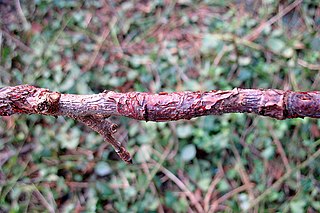
Neonectria ditissima is a fungal plant pathogen. It causes cankers that can kill branches of trees by choking them off. Apple and beech trees are two susceptible species.
Leucostoma persoonii is a plant pathogen, which causes perennial canker . On Species Fungorum the current name is given as Cytospora leucostoma (Pers.) Sacc., (1881)

Lasiodiplodia theobromae is a plant pathogen with a very wide host range. It causes rotting and dieback in most species it infects. It is a common post harvest fungus disease of citrus known as stem-end rot. It is a cause of bot canker of grapevine. It also infects Biancaea sappan, a species of flowering tree also known as Sappanwood.
Peniophora sacrata is a species of fungus in the family Peniophoraceae. A plant pathogen, the fungus causes Peniophora root and stem canker on apple trees.
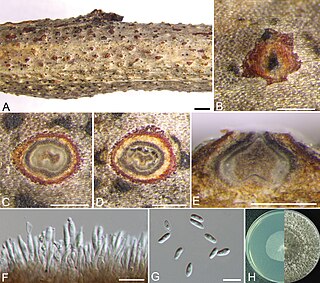
Diaporthe eres is a fungal plant pathogen, which is the type species of genus ''Diaporthe''. It causes canker disease in a wide variety of hosts. This species has a long history, having been described many times under various synonyms, for instance, the fungus was illustrated by James Sowerby in 1803 under the name Sphaeria ciliaris, attributed to Bulliard. The name D. eres has been proposed for conservation in order to avoid bothersome name changes due to priority.

Diaporthales is an order of sac fungi.
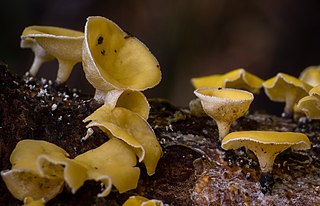
Lachnellula is a genus of fungi in the family Lachnaceae. The genus contains 40 species. Lachnellula was circumscribed in 1884 by Petter Karsten, with Lachnellula chrysophthalma assigned as the type species.

Thousand cankers disease (TCD) is a recently recognized disease of certain walnuts. The disease results from the combined activity of the walnut twig beetle and a canker producing fungus, Geosmithia morbida. Until July 2010 the disease was only known to the western United States where over the past decade it has been involved in several large scale die-offs of walnut, particularly black walnut, Juglans nigra. However, in late July 2010 a well-established outbreak of the disease was found in the Knoxville, Tennessee, area. This new finding is the first locating it within the native range of its susceptible host, black walnut. In 2013, an outbreak was found in the Veneto region of Italy, where the disease has been found on both black walnut and English walnut.
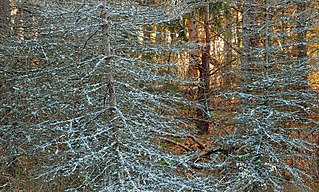
Cytospora is a genus of ascomycete fungi. The genus was first described in 1818 by Christian Gottfried Ehrenberg. Cytospora species are known as plant pathogens.

Fusarium circinatum is a fungal plant pathogen that causes the serious disease pitch canker on pine trees and Douglas firs. The most common hosts of the pathogen include slash pine, loblolly pine, Monterey pine, Mexican weeping pine, and Douglas fir. Like other Fusarium species in the phylum Ascomycota, it is the asexual reproductive state of the fungus and has a teleomorph, Gibberella circinata.

Entoleuca mammata is a species of fungus in the genus Entoleuca. It is responsible for the plant disease hypoxylon canker in hardwood trees such as quaking aspen and other aspens and poplars, Salix myrsinifolia and other willow species, rowan, Sitka alder, birch, apple, oak, and hop-hornbeam.

Clara Henriette Hasse was an American botanist whose research focused on plant pathology. She is known for identifying the cause of citrus canker, which was threatening crops in the Deep South.
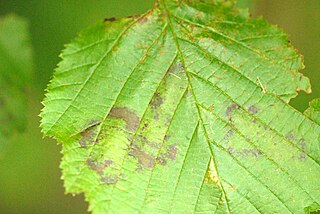
Asteroma is a genus of pathogenic fungus in the family Gnomoniaceae, containing several species that cause leaf spot and canker on plants such as goldenrod, primrose, and Erythronium.
Neofusicoccum arbuti is a fungus species in the genus Neofusicoccum. It was first described by D.F. Farr & M. Elliott, and given its current name by Crous, Slippers & A.J.L. Phillips in 2006. Neofusicoccum arbuti is included in the genus Neofusicoccum and the family Botryosphaeriaceae. This species is known as madrone canker. N. arbuti is a potentially lethal canker disease of Pacific madrone, Arbutus menziesii.














